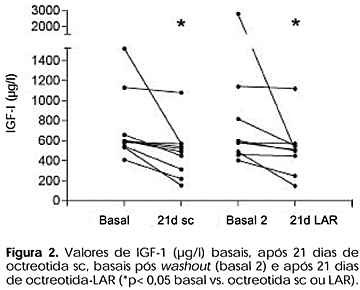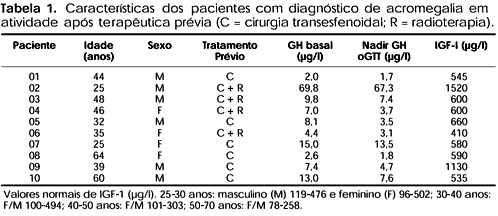We evaluated GH, IGF-1 and IGFBP-3 concentrations in ten acromegalic patients before and after treatment with subcutaneous octreotide (OCT-sc) and long-acting octreotide (OCT-LAR). We also evaluated the acute and short-period treatment (post 21 days) with octreotide as an index to test tolerance and responsiveness to both formulations. Patients were also evaluated after 6 months of treatment with each drug. Pre-treatment fasting GH (µg/l; IFMA), GH nadir during oGTT and IGF-1 (µg/l; IRMA) levels were 13.9±6.3; 11.4±6.3; 717±107, respectively. Fasting GH and IGF-1 were reduced after short treatment with OCT-sc or OCT-LAR (2.9±1.1 and 4.4±1.2; 491±80 and 512±80). All parameters were also reduced after a six-month period with OCT-sc or OCT-LAR (2.8±0.9 and 1.9±0.5; 1.6±0.4 and 1.6±0.5; 583±107 and 515±83), respectively. The efficacy of the two drugs was similar. IGFBP-3 was not a good parameter during follow-up of these patients. The acute test with OCT-sc was not a valuable index to predict tolerance, however, as well as the short-period test, it could predict the long-term GH responsiveness to OCT.
Acromegaly; Octreotide; GH; IGF-1; IGFBP-3





